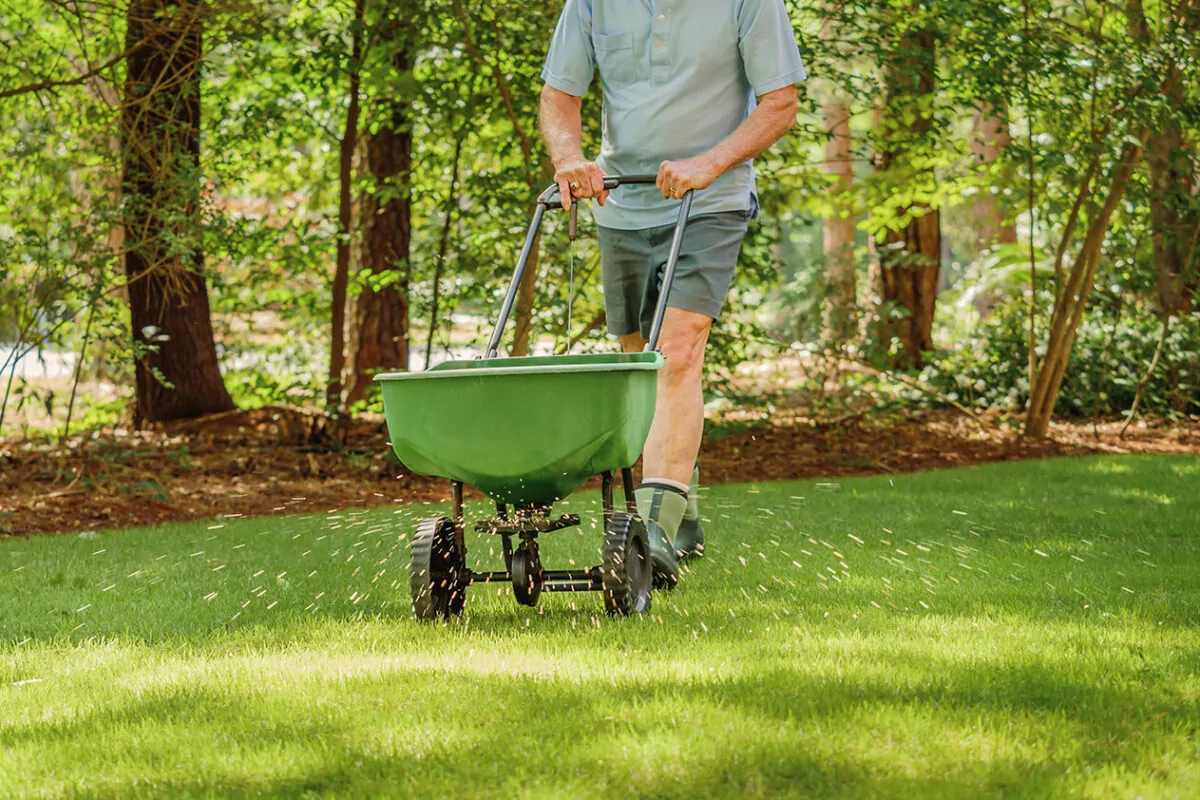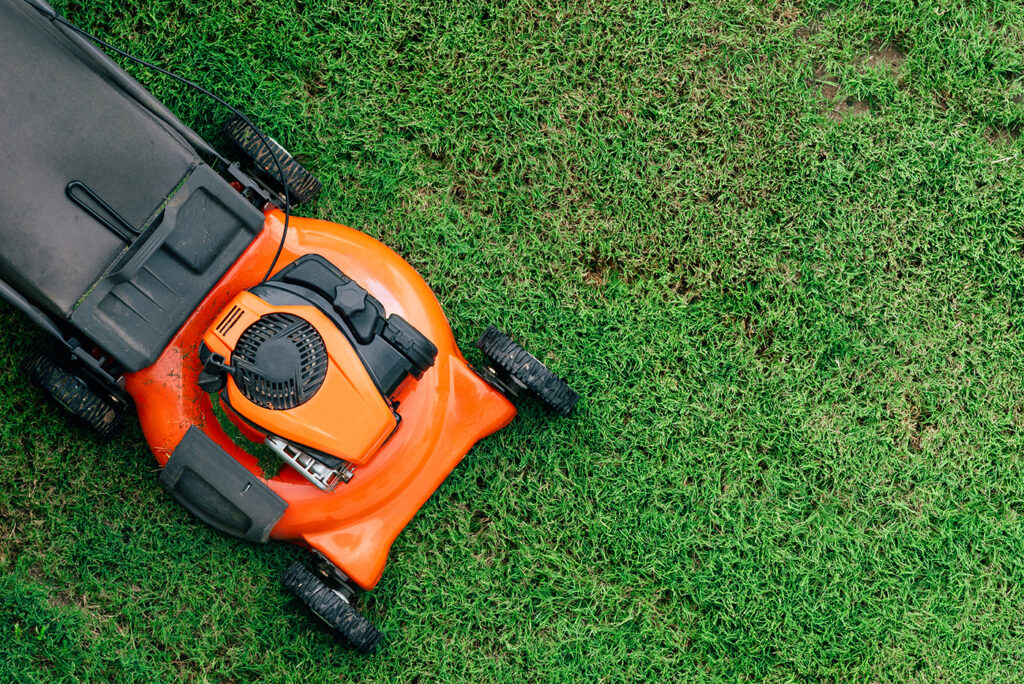A well-maintained lawn is more than just green grass; it’s the backdrop for memories, outdoor activities, and first impressions. Whether hosting a barbecue or enjoying a sunny afternoon, a lush lawn enhances the experience. Read on to learn DIY lawn care essentials, helping you create and maintain a vibrant lawn all year long.
Grass Roots: The Foundation of Great Care

Understanding your lawn is essential for making good lawn care decisions. Check out the following tips before getting started.
Identify Your Grass Type
Grass comes in many varieties, each with its own needs. Generally, there are two main types:
- Cool-season grasses: These do well in northern areas with cold winters and mild summers, like Kentucky bluegrass, fescue, and ryegrass.
- Warm-season grasses: These are best for southern areas with hot summers and mild winters, like Bermuda grass, zoysia, and St. Augustine.
Knowing your grass type is important for determining mowing height and fertilization schedules. If you’re unsure, take a sample to your local nursery or extension office for identification.
Soil Testing: The Secret to a Thriving Lawn

Your grass is only as good as the soil it grows in. Conducting a soil test is like giving your lawn a physical—it reveals vital information about pH levels and nutrient content. Here’s how to do it:
- Collect soil samples from various parts of your lawn, about 6 inches deep.
- Mix these samples and send them to a local extension office or soil testing lab.
- Interpret the results and adjust accordingly. For instance, if your soil is too acidic (low pH), you might need to add lime. If it’s too alkaline, sulfur can help bring it down.
Remember, optimal pH for most grasses is between 6.0 and 7.0. Balancing your soil’s pH and nutrient levels sets the stage for a lawn that’s both resilient and vibrant.
The Blade Runner: Mastering The Art and Science of Cutting Grass

Mowing is a fundamental lawn care task that, when done correctly, promotes healthy growth. Proper mowing techniques can make or break your lawn’s health.
Proper Mowing Techniques
- Keep your mower blades sharp. Dull blades tear grass instead of cutting it cleanly, leaving it vulnerable to disease.
- Follow the “one-third rule”: Never remove more than one-third of the grass blade’s height in a single mowing.
- Adjust your mowing height based on your grass type:
- Cool-season grasses: 2.5 to 4 inches
- Warm-season grasses: 1 to 3 inches
Mowing Schedule
Consistency is key when it comes to mowing. The frequency of mowing depends on the grass growth rate and the season. During peak growing seasons cool-season grasses might need mowing twice a week whereas warm-season grasses typically require weekly mowing.
Pro tip: Vary your mowing pattern each time to prevent soil compaction and to encourage upright growth.
Watering: Quenching Your Lawn’s Thirst Without Drowning It

Water is life for your lawn, but too much or too little can spell disaster. Mastering the art of watering is crucial for maintaining a healthy, drought-resistant lawn.
Optimal Watering Practices
- Water deeply and infrequently. This encourages deep root growth, making your lawn more resilient to drought.
- The best time to water is early morning or late evening to minimize evaporation and fungal growth.
- Aim for about 1 to 1.5 inches of water per week, including rainfall. Use a rain gauge or tuna can to measure.
Signs of Overwatering and Underwatering
Adjust your watering habits at the first sign of these symptoms to keep your lawn in top shape.
Overwatering signs:
- Fungal growth or mushrooms
- Spongy feel when walking on the lawn
- Runoff during watering
Underwatering signs:
- Footprints remain visible long after walking on the grass
- Grass blades turn a blue-gray color
- Soil is dry several inches deep
Fertilizing: Feeding Your Lawn for Optimal Growth

A well-fed lawn is a healthy lawn. Fertilizing provides essential nutrients that might be lacking in your soil, creating lush growth and vibrant color.
Choosing the Right Fertilizer
Fertilizers are labeled with three numbers representing the N-P-K ratio:
- Nitrogen (N) promotes leaf growth and green color.
- Phosphorus (P) supports root development.
- Potassium (K) enhances overall health and disease resistance.
Choose a fertilizer based on your soil test results and grass type. Generally, lawns need more nitrogen than other nutrients. Consider organic fertilizers for long-term soil health and synthetic ones for quick results.
Application Tips
Remember, over-fertilizing can burn your lawn and contribute to water pollution, so always follow recommended rates. Below are some additional tips when applying fertilizer.
- Use a spreader for even distribution.
- Water the lawn after fertilizing to help nutrients reach the roots.
- For cool-season grasses, focus on spring and fall applications.
- Warm-season grasses benefit most from late spring to mid-summer fertilization.
Weed Warfare: Defending Your Turf from Invaders

A healthy lawn is your best defense against weeds, but even the most well-maintained yards can face weed invasions.
Preventive Measures
- Maintain proper mowing height to shade out weed seedlings.
- Water deeply but infrequently to encourage deep grass roots.
- Use mulch in garden beds to prevent weed growth.
- Mulch grass clippings to retain moisture and suppress weeds.
Weed Identification and Removal
Common lawn weeds include dandelions, crabgrass, and clover. For small infestations, manual removal is sufficient. For larger problems, consider applying:
- Pre-emergent herbicides in early spring to prevent weed seeds from germinating, or
- Post-emergent herbicides for established weeds, choosing between selective (targets specific weeds) and non-selective (kills all plants) options.
Always read and follow herbicide instructions carefully to protect your lawn and the environment.
Aeration and Overseeding: Breathing New Life into Your Lawn

Over time, soil can become compacted, making it difficult for grass roots to grow and for water and nutrients to penetrate. Aeration and overseeding can rejuvenate a tired lawn.
Benefits of Aeration
Aeration involves creating small holes in the soil to:
- Reduce soil compaction
- Improve air circulation to roots
- Enhance water and nutrient absorption
Aerate cool-season grasses in early fall or spring, and warm-season grasses in late spring or early summer. Use a manual aerator for small lawns or a mechanical one for larger areas.
Overseeding Techniques
Overseeding introduces new grass seed to fill in bare spots and thicken the lawn. Here’s a step-by-step guide to help you get started.
- Mow the lawn short and rake to remove debris.
- Apply seed evenly using a spreader.
- Lightly rake to provide good seed-to-soil contact.
- Keep the area moist until seedlings establish.
For best results, overseed immediately after aerating. Overseed cool-season grasses in the fall and warm-season grasses in late spring.
Pest Patrol: Keeping Your Lawn Bug-Free and Beautiful

A healthy lawn is more resistant to pests and diseases, but vigilance is key to catching problems early.
Identifying Common Pests and Diseases
If you notice any of the following issues, take prompt action.
- Grubs: Grubs are C-shaped larvae that feed on grass roots and cause brown patches.
- Chinch bugs: These tiny insects suck plant juices, leading to dried-out areas.
- Brown patch: Any circular brown areas in the lawn indicates a fungal disease.
- Powdery mildew: Grass mildew is fungal infection that appears as a white, powdery coating on grass blades.
Organic and Chemical Control Methods
A combination of organic and chemical methods can effectively manage lawn pests and diseases. Check out the below tips to keep your lawn healthy and pest-free.
- Encourage beneficial insects like ladybugs and praying mantises.
- For grubs, consider milky spore or beneficial nematodes.
- Manage fungal diseases by avoiding overwatering and improving air circulation.
- Use insecticidal soaps for pest control as a safer alternative to chemical pesticides.
- If chemical control is necessary, choose products specific to your problem and follow instructions meticulously.
Seasonal Lawn Care Tips

Each season brings specific tasks to keep your lawn in top condition. Explore the essential tasks for each season to keep your lawn thriving year round:
Spring
- Clean up winter debris and gently rake to remove dead grass.
- Test soil and apply lime if needed.
- Begin mowing when grass starts actively growing.
- Apply a balanced fertilizer to kickstart growth.
- Dethatch if necessary to promote healthy root development.
Summer
- Raise mowing height to reduce heat stress.
- Water deeply and early in the morning.
- Stay on top of weed control.
- Increase watering frequency during hot, dry spells.
Fall
- Aerate and overseed cool-season lawns.
- Continue mowing until growth stops.
- Apply fall fertilizer to strengthen roots for winter.
- Rake leaves to prevent smothering grass.
Winter
- Minimize foot traffic on frozen grass.
- Plan for next year’s lawn care strategy.
- Maintain equipment for the coming spring.
Picture Perfect: Maintaining a Lush Lawn

Creating and maintaining a lush, healthy lawn is a rewarding journey that requires patience, consistency, and a bit of know-how. By following these essential DIY lawn care tips, you’re well on your way to maintaining the lawn of your dreams. Remember, every lawn is unique, so don’t be afraid to adjust these guidelines to suit your specific needs and conditions.
As you embark on your lawn care adventure, keep in mind that Rome wasn’t built in a day – and neither is a perfect lawn. Celebrate small victories, learn from setbacks, and enjoy the process of nurturing your outdoor space.
Lawn Rangers: When to Call in the Tasker Cavalry

While DIY lawn care can be incredibly satisfying, we understand that life can get busy. Sometimes, you need an extra set of hands to get everything done, especially when preparing for special occasions or tackling big projects. That’s where Taskers come in!
Whether you need help prepping your lawn for a summer barbecue, assembling new outdoor furniture for your freshly manicured yard, or mounting a TV in the patio to enjoy the big game, Taskers are here to help. So go ahead, transform your lawn into the oasis you’ve always dreamed of. And when you need a little extra help, remember that Taskers are just a click away, ready to help you make the most of your outdoor space and free time. Here’s to greener pastures and more time to enjoy them!














